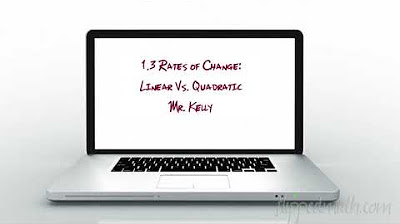Aula 02 - Função do Segundo Grau (Função Quadrática): Concavidade de uma Parábola
Summary
TLDRThis video lesson covers quadratic functions and the key concept of concavity in parabolas. It explains how the coefficient 'a' in a quadratic equation affects the direction of the parabola's opening. If 'a' is positive, the parabola opens upward, and if 'a' is negative, it opens downward. The lesson uses simple mnemonics, comparing positive and negative emotions to concavity direction, to help students remember the concept. Several examples are worked through, including finding values of 'm' to ensure the function is quadratic and to determine the direction of concavity, helping students grasp these essential mathematical concepts.
Takeaways
- 😀 Concavity of a parabola is determined by the sign of the coefficient 'a' in a quadratic function.
- 😀 When 'a' is positive (a > 0), the parabola opens upwards, like a happy face (concave up).
- 😀 When 'a' is negative (a < 0), the parabola opens downwards, like a sad face (concave down).
- 😀 You can identify the concavity of a parabola without seeing the graph by simply analyzing the coefficient 'a'.
- 😀 If 'a' > 0, the parabola is concave up, and the graph resembles a smiling face.
- 😀 If 'a' < 0, the parabola is concave down, and the graph resembles a frowning face.
- 😀 The shape of a parabola depends on whether the coefficient 'a' is positive or negative.
- 😀 The video does not cover how to graph quadratic functions but focuses on analyzing concavity.
- 😀 A quadratic function is defined as a second-degree polynomial where the coefficient 'a' cannot be zero.
- 😀 To determine if a quadratic function is valid, the coefficient 'a' must be different from zero.
- 😀 A problem example was given where the value of 'm' in the quadratic function affects the concavity and validity of the function.
Q & A
What is the main focus of this lesson?
-The lesson primarily focuses on understanding the concavity of parabolas and how to analyze the properties of quadratic functions, particularly through the coefficient of 'a' in the quadratic equation.
How can the concavity of a parabola be identified?
-The concavity of a parabola can be identified by the sign of the coefficient 'a' in the quadratic equation. If 'a' is positive, the concavity is upward; if 'a' is negative, the concavity is downward.
What does a positive 'a' coefficient signify in terms of the parabola's shape?
-A positive 'a' coefficient results in a parabola that opens upwards, which is represented by a 'happy face' or a positive, smiling shape.
What does a negative 'a' coefficient signify in terms of the parabola's shape?
-A negative 'a' coefficient results in a parabola that opens downwards, which is represented by a 'sad face' or a negative, frowning shape.
Why is it important to understand the concavity of a parabola when analyzing quadratic functions?
-Understanding the concavity is crucial because it helps determine the direction in which the parabola opens, which in turn influences the function's behavior, such as its maximum or minimum points.
In the example with the coefficient 'a' equal to 1, what can we conclude about the concavity?
-Since the coefficient 'a' is positive (1), the concavity is upwards, meaning the parabola opens upwards.
What happens when the coefficient 'a' is negative, like -4 in the example?
-When the coefficient 'a' is negative (like -4), the concavity of the parabola is downward, meaning the parabola opens downwards.
What is the purpose of the problem involving finding the value of 'm' in the quadratic function?
-The problem is designed to help students practice determining when a quadratic function is valid (i.e., a second-degree function) by ensuring that the coefficient 'a' is not equal to zero, and also to analyze the concavity of the function.
How does the concavity change in the function when 'a' is negative, as seen in the problem?
-When 'a' is negative, as shown in the problem, the concavity of the parabola changes to downward, reflecting a negative value, which corresponds to a 'sad face' or a downward-opening parabola.
How would you describe the relationship between the signs of 'a' and the behavior of the parabola?
-The sign of 'a' directly determines the direction in which the parabola opens. A positive 'a' leads to an upward-opening parabola, while a negative 'a' leads to a downward-opening parabola.
Outlines

このセクションは有料ユーザー限定です。 アクセスするには、アップグレードをお願いします。
今すぐアップグレードMindmap

このセクションは有料ユーザー限定です。 アクセスするには、アップグレードをお願いします。
今すぐアップグレードKeywords

このセクションは有料ユーザー限定です。 アクセスするには、アップグレードをお願いします。
今すぐアップグレードHighlights

このセクションは有料ユーザー限定です。 アクセスするには、アップグレードをお願いします。
今すぐアップグレードTranscripts

このセクションは有料ユーザー限定です。 アクセスするには、アップグレードをお願いします。
今すぐアップグレード関連動画をさらに表示

How to Graph Quadratic Functions by finding the Vertex, Axis of symmetry, X & Y intercepts

FUNÇÃO DO 2º GRAU: DEFINIÇÃO E GRÁFICO

AP Precalculus – 1.3 Rates of Change Linear and Quadratic Functions

FUNÇÃO DO 2º GRAU | FÁCIL E RÁPIDO

Fungsi Kuadrat [Part 6] - Bentuk Umum Fungsi Kuadrat

Introduction to Exponential Functions - Nerdstudy
5.0 / 5 (0 votes)
